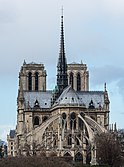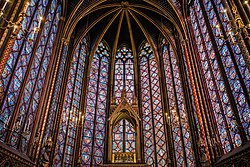Top left: Notre-Dame de Paris; top right: rose window, Notre-Dame de Paris; center left: interior of Chartres Cathedral; center right: Reims Cathedral; bottom: Sainte-Chapelle, Paris | |
| Years active | 1140 to 16th century |
|---|---|
| Location | France |
French Gothic architecture is an architectural style which emerged in France in 1140, and was dominant until the mid-16th century. The most notable examples are the great Gothic cathedrals of France, including Notre-Dame Cathedral, Reims Cathedral, Chartres Cathedral, and Amiens Cathedral. Its main characteristics are verticality, or height, and the use of the rib vault and flying buttresses and other architectural innovations to distribute the weight of the stone structures to supports on the outside, allowing unprecedented height and volume. The new techniques also permitted the addition of larger windows, including enormous stained glass windows, which fill the cathedrals with light.
French scholars divide the Gothic of their country into four phases:[1] British and American historians use similar periods.
- Gothique primitif (Primary Gothic) or Gothique premier (First Gothic), from short before 1140 until shortly after 1180, marked by tribunes above the aisles of basilicas. The British and American term for the period is Early Gothic.[2]
- Gothique Classique or (Classic Gothic), from the 1180s to the first third of 13th century, marked by basilicas without lateral tribunes and with triforia without windows. The British and American term is for the period is High Gothic. and Some buildings of this phase, like Chartres Cathedral, are included in Early Gothic; others, like the Reims Cathedral and the western parts of Amiens Cathedral, are included in High Gothic.
- Gothique rayonnant (Shining Gothic), from the second third of 13th century to the first half of 14th century, marked by triforia with windows and a general preference for stained glass instead of stone walls. It forms the greater portion of High Gothic. American and British historians also use the term Rayonnant.[3]
- Gothique flamboyant (Flaming Gothic), since mid 14th century, marked by swinging and flaming (that makes the term) forms of tracery. British and American historians use the same term.[4]
French scholars divide the Gothic of their country into four phases:[5] British and American historians use similar periods.
The French style was widely copied in other parts of northern Europe, particularly Germany and England. It was gradually supplanted as the dominant French style in the mid-16th century by French Renaissance architecture.[6]
- ^ "Beauvais, cathédrale Saint-Pierre – Eglises de l'Oise".
- ^ Encyclopedia Britannica, "Gothic architecture" (by subscription) (retrieved
- ^ Encyclopedia Britannica, "Gothic architecture" (by subscription) (retrieved
- ^ Encyclopedia Britannica, "Gothic architecture" (by subscription) (retrieved
- ^ "Beauvais, cathédrale Saint-Pierre – Eglises de l'Oise".
- ^ Ducher 1988, p. 46–54.




